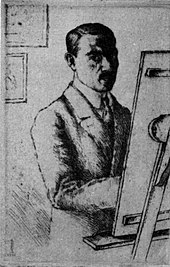Joseph Budko
Joseph Budko (born August 27, 1888 in Płońsk , Russian Empire ; died July 17, 1940 in Jerusalem , League of Nations mandate for Palestine ) was a Jewish-Polish artist who mainly worked in Berlin and later in Jerusalem.
Life
Budko studied at the Vilna art school as early as 1902 . In 1909 he came to Berlin, where he learned the craft of chasing and copperplate engraving . From 1910 he studied at the teaching facility of the Berlin Museum of Applied Arts and under Hermann Struck , whose favorite pupil was Budko. From the mid-1920s onwards, he increasingly devoted himself to painting. In 1933 Joseph Budko emigrated to Palestine , where he was director of the New Bezalel School for Arts & Crafts in Jerusalem from 1934 to 1940 .
Budko was an accomplished graphic artist who stood out primarily with etchings , drypoint and woodcuts . He created numerous illustrations, including Die Juden von Bacharach (1921) by Heinrich Heine , Psalmen (1919), The Babylonian Talmud (1924) by Bialik and for works by Schalom Asch , Schmarja Gorelik, David Frischmann , Arno Nadel and Scholem Alejchem as well as excellent Bookplate in which he often used Hebrew characters. Budko designed book covers (e.g. for the Jüdische Bücherei series) and signets (e.g. for the New Jewish Monthly Issues) for the Jewish publishing house , the Fritz Gurlitt publishing house for Jewish art and culture, and the Eschkol publishing house. Budko strived for Jewish art based on traditional Jewish symbolism and ideas. In this context, his portfolios with clearly religious statements, e.g. B. Haggada schel Pessach (26 drypoint works, 1917), or individual graphics, especially the mezzotint sheets such as The angry Moses or Jeremias comforts the mother Rachel , can be seen (all between 1917 and 1930). Another thematic area of Budko is the familiar world of the East Jewish Shtetlech from his youth as well as the motif of the Eternal Jew , which he often depicts in the confrontation of an old man with a young woman. After 1933 he also dealt with Israeli landscapes in his art.
literature
- Budko, Joseph . In: Hans Wolfgang Singer (Ed.): General Artist Lexicon. Life and works of the most famous visual artists . Prepared by Hermann Alexander Müller . tape 6 : Second addendum with corrections . Literary Institute, Rütten & Loening, Frankfurt a. M. 1922, p. 42 ( Textarchiv - Internet Archive ).
- Karl Schwarz : Hagadah illustrations by Josef Budko (on the occasion of their exhibition in the Berlin Secession). In: New Jewish monthly books. Vol. 1, 1917, issue 19, July 10, 1917, pp. 559-561.
- Karl Schwarz: The Year of the Jew. New etchings by Joseph Budko. In: New Jewish monthly books. Vol. 3, 1919, issue 15, May 10, 1919, pp. 325-326.
- Alexander Melnik: Joseph Budko. In: New Jewish monthly books. Vol. 4, Issue 11/12, March 10-25, 1920, pp. 272-273.
- Budko, Joseph. In: Joseph Walk (ed.): Short biographies on the history of the Jews 1918–1945. Saur, Munich 1988, ISBN 3-598-10477-4 , p. 49.
- Budko, Joseph. In: Werner Röder; Herbert A. Strauss (Ed.): International Biographical Dictionary of Central European Emigrés 1933-1945. Volume 2.1. Saur, Munich 1983, ISBN 3-598-10089-2 , p. 167.
- Chaim Frank: Budko, Joseph . In: General Artist Lexicon . The visual artists of all times and peoples (AKL). Volume 15, Saur, Munich a. a. 1996, ISBN 3-598-22755-8 , p. 21.
Web links
- Works by Joseph Budko in the Jewish Museum Berlin (will gradually be made available online)
Individual evidence
| personal data | |
|---|---|
| SURNAME | Budko, Joseph |
| BRIEF DESCRIPTION | Polish artist |
| DATE OF BIRTH | August 27, 1888 |
| PLACE OF BIRTH | Płońsk , Poland |
| DATE OF DEATH | 17th July 1940 |
| Place of death | Jerusalem |


